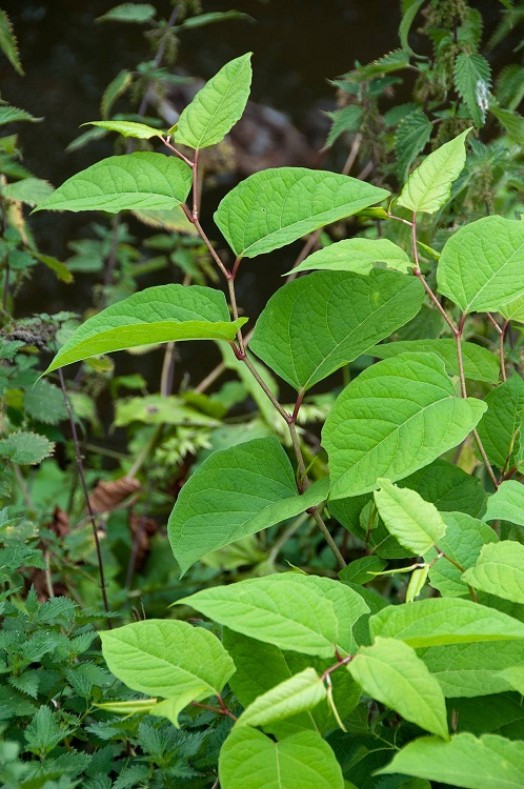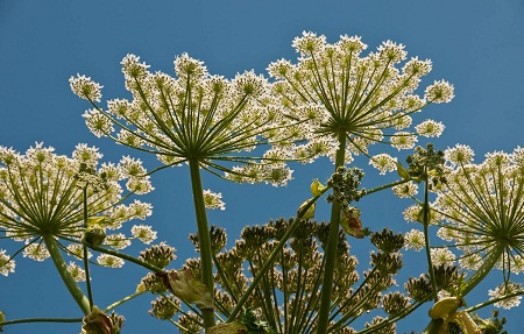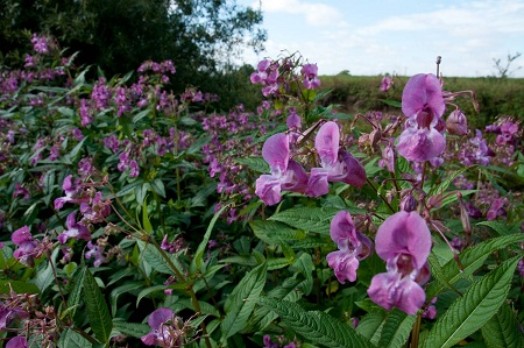Supporting guidance for Control of Invasive Non-native Plant Species – Follow-up Monitoring and Treatment
Date published: 19 December, 2023
For recent changes to this guidance, please see the bottom of the page.
Japanese knotweed, giant hogweed and Himalayan balsam are non-native plants that out-compete native grasses and herbs. They are widespread throughout most of Scotland, with the exception of the Highlands and Islands. They often grow on river banks and disturbed ground and are mainly spread by running water and movements of soil.
Identifying invasive non-native plants
It is important that you can identify invasive plants on your premises. This will allow you to manage and deal with them in the most appropriate way.

Japanese knotweed (Fallopia japonica) also giant knotweed and hybrid species (F. sachalinensis and F. x bohemica)
- tall plant with lush green, shield shaped leaves and bamboo-like stems that are often purple speckled
- forms dense thickets usually on disturbed ground or along water bodies
- can be found in almost any habitat
- very adaptable and tenacious

Giant hogweed (Heracleum mantegazzianum)
- extremely tall plant (up to five metres tall), with a blotchy purple hollow stem
- leaves are very large and sharply divided
- central stem usually produces a single large flower head, made up of numerous white flowers. Additional flower heads on side stalks
- most common on riverbanks, but can be found in most habitats

Himalayan balsam (Impatiens glandulifera)
- long slender serrated leaves on a hollow fleshy stem, produces showy pink, white or purple flowers, and exploding seedpods
- forms large single species stands, usually on river banks and in damp woodland
Why control invasive non-native plants on your land?
Japanese knotweed, giant hogweed and Himalayan balsam form dense stands that crowd out native vegetation. They die back completely in winter, leaving river banks bare and prone to erosion by flood waters. Compared to native plants, they support fewer insects, which are food for birds, fish and other wildlife. They are easily spread downstream by running water, where they invade gardens and recreation areas.
How best to control invasive non-native plants on your land
Japanese knotweed, giant hogweed and Himalayan balsam are easily spread by running water and along roads and railways. Because of this, control will be far more successful if it is coordinated across a large area such as a river catchment, and not in a piecemeal fashion on individual holdings.
Your control programme should consist of an initial treatment and repeated follow-up treatments. A single primary chemical or mechanical treatment will not be sufficient, and in the absence of follow-up treatments, invasive non-native plants will quickly recover and the benefits of the primary treatment will be lost. A control programme should cover a five-year period and several different control measures might be required.
Control measures can include chemical control, manual (hand cutting, hand pulling), mechanical (cutting / strimming) or a combination of these methods, as well as the use of livestock. Chemical control is the most cost-effective method for treating Japanese knotweed and large stands of giant hogweed and Himalayan balsam. You need to consider the slope and accessibility of the site as well as the extent
of the infestation when choosing a control treatment.
Chemical
Japanese knotweed, giant hogweed and Himalayan balsam can all be controlled with herbicide.
Glyphosate-based herbicides are licensed for use near water.
The impact on non-target species can be reduced by using stem injection or a weed wiper to apply herbicide to Japanese knotweed or giant hogweed.
However, for Himalayan balsam and larger stands of Japanese knotweed or giant hogweed, it is more efficient to spray the leaves using a knapsack sprayer.
Manual and mechanical
Himalayan balsam
Hand pulling is an effective method for dealing with individual or scattered plants. These can be safely composted on site. Strimming is effective provided the stems are cut below the lowest node.
Giant hogweed
Cutting the tap-root, by inserting a sharp spade at an angle to the soil, kills the plant and is suitable for small stands or sensitive sites. Grazing or mowing gradually weakens the plant over a number of years. Seek advice from NatureScot before including grazing or mowing in your plan.
WARNING! The sap of giant hogweed can cause severe blistering to the skin.
Wear protective clothing and avoid contact with any part of the plant.
WARNING! Do not cut or strim Japanese knotweed.
Stem and root fragments are easily spread and take root.
Aims of management
The timing and frequency of treatments is important. They are designed to exploit weaknesses in the plants’ lifecycles to enable them to be controlled more easily.
Japanese knotweed does not set seed in Scotland. It spreads by plant fragments taking root. The aim of treatment is to maximise the uptake of herbicide into the roots. One treatment per year is sufficient, although it may take up to three years to kill the plant.
Giant hogweed reproduces by seed alone. It flowers only once in its lifetime, producing a massive flower stem with up to 8000 seeds. The aim of initial treatment is to eradicate plants and continue control throughout the growing season so that no plants flower and set seed. Follow-up treatments must provide consistent repeat control to prevent plants from flowering, until the seed bank is exhausted. This may take three to five years.
Himalayan balsam has exploding seed heads that scatter as many as 800 seeds for a distance of up to seven metres. The aim of initial treatment is to eradicate plants and continue control throughout the growing season so that no flowers set seed. Individual flowers are easily missed amongst long vegetation; therefore follow-up treatments must provide consistent repeat control, until the population has been eradicated. This may take two to five years.
Timing of treatments
It is important to follow these schedules for treatment. The exact timing may vary depending on which part of the country you are in and the weather that year.
| Japanese knotweed | Apply herbicide in August / September to maximise uptake into the roots. |
| Giant hogweed |
Initial treatment in April / May before the plants grow too big to treat. Follow-up treatments July / August for plants 'released' by opening canopy. |
| Himalayan balsam |
Begin treatment in July, or within three weeks of the first flowers. Follow-up treatments every three weeks until first frost of autumn. |
Do you require consent?
If you are proposing to use chemical control, you may need to consult the appropriate bodies. These include the Scottish Environment Protection Agency, NatureScot, your local water authority, and your local authority environmental services.
Depending on the circumstances, this may take place as part of the AECS application process, or as a separate application. It is your responsibility to determine who you legally need to contact.
If spraying within one metre of the top of the bank of a watercourse, you, or your spray operator need to consult Scottish Environment Protection Agency in advance and must hold a PA6aw certificate.
After the initial control work
You will have to carry out follow-up treatment and monitoring to deal with any regrowth and spread of invasive plants. In addition to the locations where you carried out initial treatment, you will need to search vulnerable habitats (water margins, grassland, scrub and woodland) nearby for any invasive plants that have spread there. There are several ways by which invasive plants spread:
| Dispersal mechanism | Frequency | Approx. distance travelled | Habitats commonly affected |
| Seeds falling from plants | Very frequent | 0–10m | Any habitat within 10m of plant |
| Wind / animals / people / mowing | Moderately frequent | At least 50m | Habitats connected by flat surfaces or paths |
| Watercourse – spread downstream | Very frequent | Over 1km | Any habitats downstream |
| Railway lines and roads | Frequent | 0–100m | Habitats next to railways and roads |
Table: Invasive plant dispersal mechanisms
You need to search vulnerable habitats within 50 metres of known locations for invasive plants. You should extend your search to 100 metres along roads and railway-lines. If invasive plants are within 10 metres of a watercourse, you will need to search all of the banks downstream from this point on your holding. Where invasive plants are spreading beyond the boundaries of your holding, your control plan must be coordinated with action on the neighbouring holdings.
Invasive plant material can lie dormant in the soil for several years, therefore you will need continue follow-up monitoring after the last re-growth of invasive plants.
Invasive Plant Management Plan
If you are applying to manage invasive non-native plants you will need to prepare and implement a systematic programme of treatment and follow-up actions, as specified within an Invasive Plant Management Plan, to be submitted with your application.
Your plan should include the locations and extent of all Japanese knotweed, giant hogweed and Himalayan balsam on your holding:
- map the extent of invasive plants at 1:2,500-scale (1 centimetre = 25 metres)
- locations of stands may be mapped to within 15 metres using a standard GPS.
- for each stand record: location, extent in square metres, ID photo, sensitive features nearby
- measure extent accurately for stands over five metres square (size of a small car)
Your plan should identify the type of treatment and proposed timing for species of invasive plant in each location.
Your plan should also describe the following:
- location of any areas previously cleared of invasive non-native plants
- potential corridors of spread along rivers, roads, railway lines and paths
- vulnerable habitats such as water margins, grassland, scrub and woodland
- locations of sensitive areas, such as watercourses, plants of conservation interest and resting places used by otters, that may be damaged or disturbed by the control methods
Your plan should aim to:
- minimise impacts of herbicide on non-target species and sensitive areas
- work strategically, starting at the top of river catchments and working downstream
- divide large programmes into manageable sections and phase work over several years
- co-ordinate effort across all affected land to eliminate potential sources of re-invasion
Future management and monitoring
It is important that land cleared of invasive plants is maintained to prevent re-invasion or regrowth. Invasive plant material that has been lying dormant in the soil may re-grow when the ground is disturbed. Re-invasion may also occur when seeds or plant fragments are inadvertently carried in from elsewhere on vehicles or footwear or by animals.
Your Invasive Plant Management Plan should describe what you will do to monitor the success of the invasive plant control and deal with any re-growth or re-invasion.
Restoration and management of habitats can reduce the risk of re-invasion. Your plan should also describe how you will manage the area on an ongoing basis
